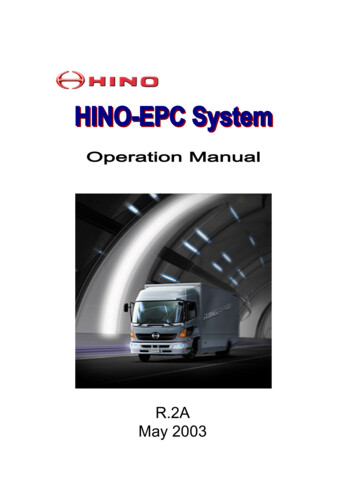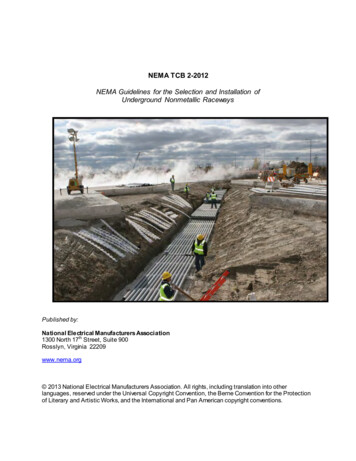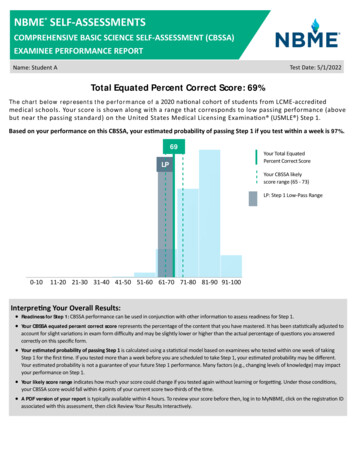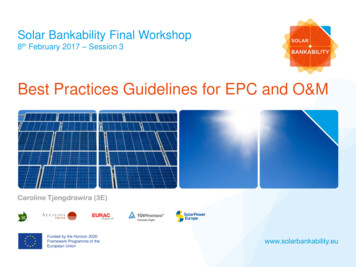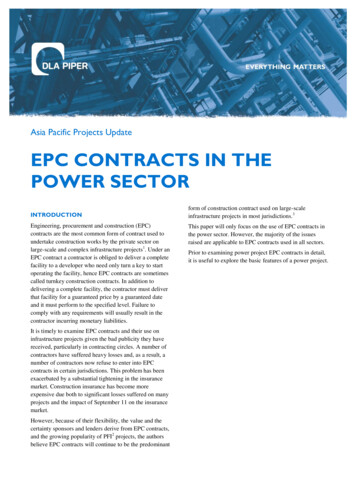
Transcription
Asia Pacific Projects UpdateEPC CONTRACTS IN THEPOWER SECTORINTRODUCTIONEngineering, procurement and construction (EPC)contracts are the most common form of contract used toundertake construction works by the private sector onlarge-scale and complex infrastructure projects1. Under anEPC contract a contractor is obliged to deliver a completefacility to a developer who need only turn a key to startoperating the facility, hence EPC contracts are sometimescalled turnkey construction contracts. In addition todelivering a complete facility, the contractor must deliverthat facility for a guaranteed price by a guaranteed dateand it must perform to the specified level. Failure tocomply with any requirements will usually result in thecontractor incurring monetary liabilities.It is timely to examine EPC contracts and their use oninfrastructure projects given the bad publicity they havereceived, particularly in contracting circles. A number ofcontractors have suffered heavy losses and, as a result, anumber of contractors now refuse to enter into EPCcontracts in certain jurisdictions. This problem has beenexacerbated by a substantial tightening in the insurancemarket. Construction insurance has become moreexpensive due both to significant losses suffered on manyprojects and the impact of September 11 on the insurancemarket.However, because of their flexibility, the value and thecertainty sponsors and lenders derive from EPC contracts,and the growing popularity of PFI2 projects, the authorsbelieve EPC contracts will continue to be the predominantform of construction contract used on large-scaleinfrastructure projects in most jurisdictions.3This paper will only focus on the use of EPC contracts inthe power sector. However, the majority of the issuesraised are applicable to EPC contracts used in all sectors.Prior to examining power project EPC contracts in detail,it is useful to explore the basic features of a power project.
BASIC FEATURES OF A POWER PROJECTThe contractual structureThe diagram below illustrates the basic contractual structure of a project-financed power project using an EPC contract.The detailed contractual structure will vary from project toproject. However, most projects will have the basicstructure illustrated above. As can be seen from thediagram, the project company4 will usually enter intoagreements which cover the following elements: An agreement which gives the project company theright to construct and operate the power station andsell electricity generated by the power station.Traditionally this was a concession agreement (orproject agreement) with a relevant government entitygranting the project company a concession to buildand operate the power station for a fixed period oftime (usually between 15 and 25 years), after which itwas handed back to the government. This is why theseprojects are sometimes referred to as build operatetransfer (BOT) or build own operate transfer (BOOT)projects5.However, following the deregulation of electricityindustries in many countries, merchant power stations arenow being constructed. A merchant power project is aproject which sells electricity into an electricity marketand takes the market price for that electricity. Merchantpower projects do not normally require an agreementbetween the project company and a government entity to2 EPC Contracts in the Power Sectorbe constructed. Instead, they need simply to obtain thenecessary planning, environmental and buildingapprovals. The nature and extent of these approvals willvary from place to place. In addition, the project companywill need to obtain the necessary approvals and licences tosell electricity into the market. In traditional project-financed power projects (asopposed to merchant power projects) there is a powerpurchase agreement (PPA) between the projectcompany and the local government authority, wherethe local government authority undertakes to pay for aset amount of electricity every year of the concession,subject to availability, regardless of whether it actuallytakes that amount of electricity (referred to as a take orpay obligation). Sometimes a tolling agreement is usedinstead of a PPA. A tolling agreement is an agreementunder which the power purchaser directs how the plantis to be operated and despatched. In addition, thepower purchaser is responsible for the provision offuel. This eliminates one risk variable (for the projectcompany) but also limits its operational flexibility.In the absence of a PPA, project companies developing amerchant power plant, and lenders, do not have the samecertainty of cashflow as they would if there was a PPA.
Therefore, merchant power projects are generallyconsidered higher risk than non-merchant projects.6 Thisrisk can be mitigated by entering into hedge agreements.Project companies developing merchant power projectsoften enter into synthetic PPAs or hedge agreements toprovide some certainty of revenue. These agreements arefinancial hedges as opposed to physical sales contracts.Their impact on the EPC contract is discussed in moredetail below. A construction contract governing the construction ofthe power station. There are a number of contractualapproaches that can be taken to construct a powerstation. An EPC contract is one approach. Anotheroption is to have a supply contract, a design agreementand construction contract with or without a projectmanagement agreement. The choice of contractingapproach will depend on a number of factors includingthe time available, the lenders’ requirements and theidentity of the contractor(s). The major advantage ofthe EPC contract over the other possible approaches isthat it provides for a single point of responsibility.This is discussed in more detail below.Interestingly, on large project-financed projects thecontractor is increasingly becoming one of the sponsors iean equity participant in the project company. Contractorswill ordinarily sell down their interest after financial closebecause, generally speaking, contractors will not wish totie up their capital in operating projects. In addition, onceconstruction is complete the rationale for having thecontractor included in the ownership consortium no longerexists. Similarly, once construction is complete a projectwill normally be reviewed as lower risk than a project inconstruction, therefore, all other things being equal, thecontractor should achieve a good return on itsinvestments.In our experience most projects and almost all large,private sector, power projects use an EPC contract. An agreement governing the operation andmaintenance of the power station. This is usually along-term operating and maintenance agreement (O &M agreement) with an operator for the operation andmaintenance of the power station. The term of the O &M agreement will vary from project to project. Theoperator will usually be a sponsor especially if one ofthe sponsors is an independent power producer (IPP)or utility company whose main business is operatingpower stations. Therefore, the term of the O & Magreement will likely match the term of the concessionagreement. In some financing structures the lenderswill require the project company itself to operate thefacility. In those circumstances the O & M agreementwill be replaced with a technical services agreement3 EPC Contracts in the Power Sectorunder which the project company is supplied with theknow-how necessary for its own employees to operatethe facility. An agreement governing the supply of fuel to thepower station. This is usually a fuel supply agreement,often with the local government authority thatregulates the supply of the fuel used to run the powerstation (eg coal, fuel oil, gas etc). Obviously, if there isa tolling agreement there is no separate fuel supplyagreement. In addition, in some markets and forparticular types of projects the project company maydecide not to enter into a long-term fuel supplyagreement but instead elect to purchase fuel in the spotmarket. This will usually only be feasible for peakingplants and in locations with ample supplies of thenecessary fuel. For hydro and wind projects there isalso no need for a fuel supply agreement. However,this paper focuses on thermal plants. Many of theissues discussed will be applicable to hydro and windprojects, however, those projects have additional risksand issues that need to be taken into account. Financing and security agreements with the lenders tofinance the development of the project.Accordingly, the construction contract is only one of asuite of documents on a power project. Importantly, theproject company operates the project and earns revenuesunder contracts other than the construction contract.Therefore, the construction contract must, where practical,be tailored so as to be consistent with the requirements ofthe other project documents. As a result, it is vital toproperly manage the interfaces between the various typesof agreements. These interface issues are discussed inmore detail later.BANKABILITYA bankable contract is a contract with a risk allocationbetween the contractor and the project company thatsatisfies the lenders. Lenders focus on the ability (or moreparticularly the lack thereof) of the contractor to claimadditional costs or extensions of time as well as thesecurity provided by the contractor for its performance.The less comfortable the lenders are with these provisionsthe greater amount of equity support the sponsors willhave to provide. In addition, lenders will have to besatisfied as to the technical risk. Obviously price is also aconsideration but that is usually considered separately tothe bankability of the contract because the contract price(or more accurately the capital cost of the power station)goes more directly to the bankability of the project as awhole.Before examining the requirements for bankability it isworth briefly considering the appropriate financing
structures and lending institutions. The most commonform of financing for infrastructure projects is projectfinancing. Project financing is a generic term that refers tofinancing secured only by the assets of the project itself.Therefore, the revenue generated by the project must besufficient to support the financing. Project financing isalso often referred to as either non-recourse financing orlimited recourse financing.The terms non-recourse and limited recourse are oftenused interchangeably, however, they mean differentthings. Non-recourse means there is no recourse to theproject sponsors at all and limited recourse means, as thename suggests, there is limited recourse to the sponsors.The recourse is limited both in terms of when it can occurand how much the sponsors are forced to contribute. Inpractice, true non-recourse financing is rare. In mostprojects the sponsors will be obliged to contributeadditional equity in certain defined situations.Traditionally project financing was provided bycommercial lenders. However, as projects became morecomplex and financial markets more sophisticated projectfinance also developed. Whilst commercial lenders stillprovide finance, governments now also provide financingeither through export credit agencies7 or trans- or multinational organisations like the World Bank, the AsianDevelopment Bank and European Bank forReconstruction. In addition, as well as bank borrowingssponsors are also using more sophisticated products likecredit wrapped bonds, securitisation of future cashflowsand political risk insurance to provide a portion of thenecessary finance.In assessing bankability lenders will look at a range offactors and assess a contract as a whole. Therefore, inisolation it is difficult to state whether one approach is oris not bankable. However, generally speaking the lenderswill require the following: A fixed completion date A fixed completion price No or limited technology risk Output guarantees Liquidated damages for both delay and performance Security from the contractor and/or its parent Large caps on liability (ideally, there would be no capson liability, however, given the nature of EPCcontracting and the risks to the contractors involvedthere are almost always caps on liability) Restrictions on the ability of the contractor to claimextensions of time and additional costs.An EPC contract delivers all of the requirements listedabove in one integrated package. This is one of the major4 EPC Contracts in the Power Sectorreasons why they are the predominant form ofconstruction contract used on large-scale project financedinfrastructure projects.BASIC FEATURES OF AN EPC CONTRACTThe key clauses in any construction contract are thosewhich impact on: Time Cost Quality.The same is true of EPC contracts. However, EPCcontracts tend to deal with issues with greatersophistication than other types of construction contracts.This is because, as mentioned above, an EPC contract isdesigned to satisfy the lenders’ requirements forbankability. EPC contracts provide for: A single point of responsibility. The contractor isresponsible for all design, engineering, procurement,construction, commissioning and testing activities.Therefore, if any problems occur the project companyneed only look to one party – the contractor – to bothfix the problem and provide compensation. As a result,if the contractor is a consortium comprising severalentities the EPC contract must state that those entitiesare jointly and severally liable to the project company. A fixed contract price. Risk of cost overruns and thebenefit of any cost savings are to the contractor’saccount. The contractor usually has a limited ability toclaim additional money which is limited tocircumstances where the project company has delayedthe contractor or has ordered variations to the works. A fixed completion date. EPC contracts include aguaranteed completion date that is either a fixed dateor a fixed period after the commencement of the EPCcontract. If this date is not met the contractor is liablefor delay liquidated damages (DLDs). DLDs aredesigned to compensate the project company for lossand damage suffered as a result of late completion ofthe power station. To be enforceable in common lawjurisdictions, DLDs must be a genuine pre-estimate ofthe loss or damage that the project company will sufferif the power station is not completed by the targetcompletion date. The genuine pre-estimate isdetermined by reference to the time the contract wasentered into.DLDs are usually expressed as a rate per day whichrepresents the estimated extra costs incurred (such as extrainsurance, supervision fees and financing charges) andlosses suffered (revenue forgone) for each day of delay.In addition, the EPC contract must provide for thecontractor to be granted an extension of time when it is
delayed by the acts or omissions of the project company.The extension of time mechanism and reasons why it mustbe included are discussed later. Performance guarantees. The project company’srevenue will be earned by operating the power station.Therefore, it is vital that the power station performs asrequired in terms of output, efficiency and reliability.Therefore, EPC contracts contain performanceguarantees backed by performance liquidated damages(PLDs) payable by the contractor if it fails to meet theperformance guarantees.PLDs must also be a genuine pre-estimate of the loss anddamage that the project company will suffer over the lifeof the project if the power station does not achieve thespecified performance guarantees. As with DLDs, thegenuine pre-estimate is determined by reference to thetime the contract was signed.explicitly that liquidated damages can include elements ofconsequential damages. Given the rate of liquidateddamages is pre-agreed most contractors will not object tothis exception.In relation to both caps on liability and exclusion ofliability it is common for there to be some exceptions. Theexceptions may apply to either or both the cap on liabilityand the prohibition on claiming consequential losses. Theexceptions themselves are often project specific, however,some common examples include in cases of fraud orwilful misconduct, in situations where the minimumperformance guarantees have not been met and the cap ondelay liquidated damages has been reached and breachesof the intellectual property warranties. PLDs are usually a net present value (NPV) (lessexpenses) calculation of the revenue forgone over the lifeof the project.Security. It is standard for the contractor to provideperformance security to protect the project company ifthe contractor does not comply with its obligationsunder the EPC contract. The security takes a numberof forms including: A bank guarantee for a percentage, normally in therange of 5–15%, of the contract price. The actualpercentage will depend on a number of factorsincluding the other security available to the projectcompany, the payment schedule (because thegreater the percentage of the contract price unpaidby the project company at the time it is most likelyto draw on security ie, to satisfy DLD and PLDobligations the smaller the bank guarantee can be),the identity of the contractor and the risk of it notproperly performing its obligations, the price of thebank guarantee and the extent of the technologyrisk. Retention ie withholding a percentage (usually 5 –10%) of each payment. Provision is often made toreplace retention monies with a bank guarantee(sometimes referred to as a retention guarantee(bond)) Advance payment guarantee, if an advancepayment is made A parent company guarantee – this is a guaranteefrom the ultimate parent (or other suitably relatedentity) of the contractor which provides that it willperform the contractor’s obligations if, forwhatever reason, the contractor does not perform.For example, if the output of the plant is five MW lessthan the specification the PLDs are designed tocompensate the project company for the revenue forgoneover the life of the project by being unable to sell that fiveMW.PLDs and the performance guarantee regime and itsinterface with the DLDs and the delay regime arediscussed in more detail below. Caps on liability. As mentioned above most EPCcontractors will not, as a matter of company policy,enter into contracts with unlimited liability. Therefore,EPC contracts for power projects cap the contractor’sliability at a percentage of the contract price. Thisvaries from project to project, however, an overallliability cap of 100 percent of the contract price iscommon. In addition, there are normally sub-caps onthe contractor’s liquidated damages liability. Forexample, DLDs and PLDs might each be capped at 20percent of the contract price with an overall cap onboth types of liquidated damages of 30 percent of thecontract price.There will also likely be a prohibition on the claiming ofconsequential damages. Put simply consequentialdamages are those damages which do not flow directlyfrom a breach of contract but which were in thereasonable contemplation of the parties at the time thecontract was entered into. This used to mean heads ofdamage like loss of profit. However, loss of profit is nowusually recognised as a direct loss on project-financedprojects and, therefore, would be recoverable under acontract containing a standard exclusion of consequentialloss clause. Nonetheless, care should be taken to state5 EPC Contracts in the Power Sector Variations. The project company has the right to ordervariations and agree to variations suggested by thecontractor. If the project company wants the right toomit works either in their entirety or to be able toengage a different contractor this must be statedspecifically. In addition, a properly drafted variationsclause should make provision for how the price of avariation is to be determined. In the event the parties
do not reach agreement on the price of a variation theproject company or its representative should be able todetermine the price. This determination is subject tothe dispute resolution provisions. In addition, thevariations clause should detail how the impact, if any,on the performance guarantees is to be treated. Forsome larger variations the project company may alsowish to receive additional security. If so, this must alsobe dealt with in the variations clause. Defects liability. The contractor is usually obliged torepair defects that occur in the 12 to 24 monthsfollowing completion of the performance testing.Defects liability clauses can be tiered. That is theclause can provide for one period for the entire powerstation and a second, extended period, for more criticalitems. Intellectual property. The contractor warrants that ithas rights to all the intellectual property used in theexecution of the works and indemnifies the projectcompany if any third parties’ intellectual propertyrights are infringed. Force majeure. The parties are excused fromperforming their obligations if a force majeure eventoccurs. This is discussed in more detail below. Suspension. The project company usually has right tosuspend the works. Termination. This sets out the contractual terminationrights of both parties. The contractor usually has verylimited contractual termination rights. These rights arelimited to the right to terminate for non-payment or forprolonged suspension or prolonged force majeure andwill be further limited by the tripartite or directagreement between the project company, the lendersand the contractor. The project company will havemore extensive contractual termination rights. Theywill usually include the ability to terminateimmediately for certain major breaches or if thecontractor becomes insolvent and the right to terminateafter a cure period for other breaches. In addition, theproject company may have a right to terminate forconvenience. It is likely the project company’s abilityto exercise its termination rights will also be limited bythe terms of the financing agreements. Performance specification. Unlike a traditionalconstruction contract, an EPC contract usuallycontains a performance specification. The performancespecification details the performance criteria that thecontractor must meet. However, it does not dictatehow they must be met. This is left to the contractor todetermine. A delicate balance must be maintained. Thespecification must be detailed enough to ensure theproject company knows what it is contracting to6 EPC Contracts in the Power Sectorreceive but not so detailed that if problems arise thecontractor can argue they are not its responsibility.Whilst there are, as described above, numerousadvantages to using an EPC contract, there are somedisadvantages. These include the fact that it can result in ahigher contract price than alternative contractualstructures. This higher price is a result of a number offactors not least of which is the allocation of almost all theconstruction risk to the contractor. This has a number ofconsequences, one of which is that the contractor willhave to factor into its price the cost of absorbing thoserisks. This will result in the contractor buildingcontingencies into the contract price for events that areunforeseeable and/or unlikely to occur. If thosecontingencies were not included the contract price wouldbe lower. However, the project company would bear moreof the risk of those unlikely or unforeseeable events.Sponsors have to determine, in the context of theirparticular project, whether the increased price is worthpaying.As a result, sponsors and their advisers must criticallyexamine the risk allocation on every project. Riskallocation should not be an automatic process. Instead, theproject company should allocate risk in a sophisticatedway that delivers the most efficient result. For example, ifa project is being undertaken in an area with unknowngeology and without the time to undertake a propergeotechnical survey, the project company may be bestserved by bearing the site condition risk itself as it willmean the contractor does not have to price a contingencyit has no way of quantifying. This approach can lower therisk premium paid by the project company. Alternatively,the opposite may be true. The project company may wishto pay for the contingency in return for passing off the riskwhich quantifies and caps its exposure. This type ofanalysis must be undertaken on all major risks prior togoing out to tender.Another consequence of the risk allocation is the fact thatthere are relatively few construction companies that canand are willing to enter into EPC contracts. As mentionedin the introduction some bad publicity and a tighteninginsurance market have further reduced the pool ofpotential EPC contractors. The scarcity of EPCcontractors can also result in relatively high contractprices.Another major disadvantage of an EPC contract becomesevident when problems occur during construction. Inreturn for receiving a guaranteed price and a guaranteedcompletion date, the project company cedes most of theday-to-day control over the construction. Therefore,project companies have limited ability to intervene whenproblems occur during construction. The more a project
company interferes the greater the likelihood of thecontractor claiming additional time and costs. In addition,interference by the project company will make itsubstantially easier for contractors to defeat claims forliquidated damages and defective works.Obviously, ensuring the project is completed satisfactorilyis usually more important than protecting the integrity ofthe contractual structure. However, if a project companyinterferes with the execution of the works they will, inmost circumstances, have the worst of both worlds. Theywill have a contract that exposes them to liability for timeand costs incurred as a result of their interference withoutany corresponding ability to hold the contractor liable fordelays in completion or defective performance. The sameproblems occur even where the EPC contract is drafted togive the project company the ability to intervene. In manycircumstances, regardless of the actual drafting, if theproject company becomes involved in determining howthe contractor executes the works then the contractor willbe able to argue that it is not liable for either delayed ordefective performance.As a result, it is vitally important that great care is taken inselecting the contractor and in ensuring the contractor hassufficient knowledge and expertise to execute the works.Given the significant monetary value of EPC contracts,and the potential adverse consequences if problems occurduring construction, the lowest price should not be theonly factor used when selecting contractors.SPLIT EPC CONTRACTSOne common variation, particularly in Asia, on the basicEPC structure illustrated above is a split EPC contract.Under a split EPC contract, the EPC contract is, as thename implies, split into two or more separate contracts.7 EPC Contracts in the Power SectorThe basic split structure (illustrated below) involvessplitting the EPC contract into an onshore constructioncontract and an offshore supply contract.9There are two main reasons for using a split contract. Thefirst is because it can result in a lower contract price as itallows the contractor to make savings in relation toonshore taxes; in particular on indirect and corporate taxesin the onshore jurisdiction. The second is because it mayreduce the cost of complying with local licensingregulations by having more of the works, particularly thedesign works, undertaken offshore. In addition, in somecountries which impose restrictions on who can carry outcertain activities like engineering and design services,splitting the EPC contract can also be advantageousbecause it can make it easier to repatriate profits. Below isa diagram illustrating a more complex split EPC structurewe have used previously that dealt with both tax andlicensing issues.
EXAMPLE SPLIT EPC STRUCTUREWhilst a split EPC contract can result in costs savings,there are risks to the project company in using such astructure. This mainly arises because of the derogationfrom the principle of single point of responsibility.Unlike a standard EPC contract, the project companycannot look only to a single contractor to satisfy all thecontractual obligations (in particular, design, constructionand performance). Under a split structure, there are atleast two entities with those obligations. Therefore, a thirdagreement, a wrap-around guarantee,10 is used to deliver asingle point of responsibility despite the split.Under a wrap-around guarantee, an entity, usually eitherthe offshore supplier or the parent company of thecontracting entities, guarantees the obligations of bothcontractors. This delivers a single point of responsibilityto the project company and the lenders. The contractingentities will then enter into a separate agreement todetermine how, as between themselves, liability is to beapportioned. However, that agreement is not relevant forthe purposes of this paper.In addition, the wrap-around guarantee will, if properlydrafted, prevent the various contractors from relying onthe defaults of the other parties to avoid performing their8 EPC Contracts in the Power Sectorcontractual obligations – a tactic known as a horizontaldefence. The wrap-around guarantee should also prevent acontractor from relying on the project company’s defaultwhere the project company’s default was a result, eitherdirectly or indirectly, of the non-performance, underperformance or delay in performance of any of the othercontractors under their respective contracts.In addition to horizontal defences, the wrap-aroundguarantee should deal with the following matters: Guarantees and indemnities – the guarantor mustguarantee the performance of the totality of the worksand the ability of the separate parts to work seamlessly Liquidated damages – this is linked to the issue ofhorizontal defences discussed above. The wrap-aroundguarantee must ensure that liquidated damages arepaid regardless of whic
contractors have suffered heavy losses and, as a result, a number of contractors now refuse to enter into EPC contracts in certain jurisdictions. This problem has been exacerbated by a substantial tightening in the insurance market. Construction insurance has become more expensive due both to significant losses suffered on many


